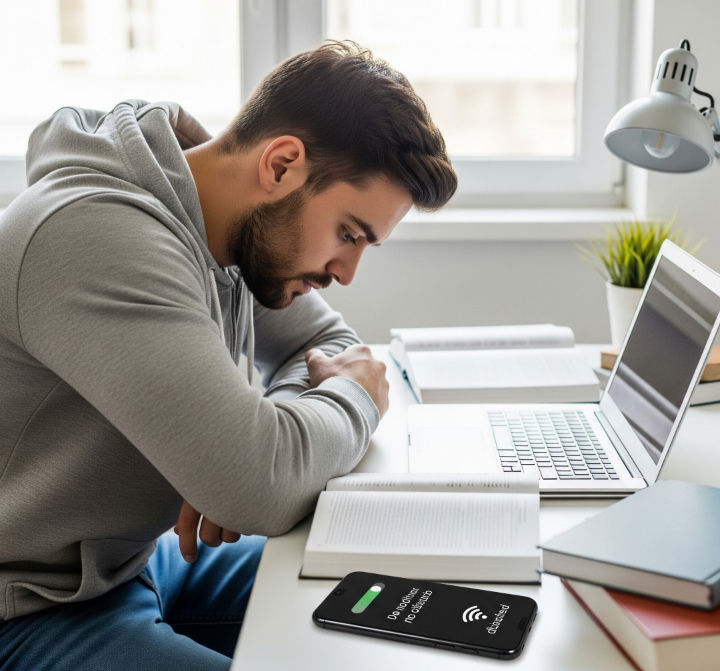Mastering Focus: Practical Strategies for Minimizing Distractions
- 2 jun
- 3 Min. de lectura
Actualizado: 17 jun

In our hyper-connected world, the constant barrage of notifications, tempting online content, and environmental noise makes minimizing distractions more challenging than ever. Yet, the ability to focus deeply is a cornerstone of productivity, effective learning, and achieving personal goals. By proactively adopting practical strategies, we can reclaim our attention and significantly enhance our capacity for concentration.
Core Strategies for Minimizing Distractions
Effectively minimizing distractions requires a multi-pronged approach, tackling both external interruptions and internal urges. Here are some highly effective and consistently emphasized strategies:
Silence Your Phone and Manage Notifications: Your smartphone is often the primary source of digital distractions.
Go truly silent: Place your phone on silent or "Do Not Disturb" mode. For deep work, consider turning it off entirely.
Curb non-essential alerts: App notifications, email pings, and social media updates constantly pull you away. Disable all non-critical notifications. Train yourself to check emails and social media at specific, designated times, rather than reactively.
Out of sight, out of mind: Even a silent phone can be a visual distraction. Keep it in another room, in a drawer, or anywhere it’s not visible from your workspace. This helps in minimizing distractions stemming from its mere presence.
Leverage Focus Apps and Tools: Technology can also be an ally in minimizing distractions.
Website blockers: These applications allow you to block access to distracting websites (like social media or news sites) for a set period. Popular examples include Freedom, Cold Turkey, or StayFocusd.
Pomodoro timers: The Pomodoro Technique encourages focused work in 25-minute intervals, separated by short breaks. Many apps are available to facilitate this. This structured approach helps train your brain for sustained focus by breaking down tasks.
Noise-canceling solutions: If environmental noise is a significant issue, invest in noise-canceling headphones or use apps that generate white noise or ambient sounds to mask disruptive sounds, thereby aiding in minimizing distractions from your surroundings.
Disconnect from Wi-Fi (When Applicable): For tasks that don't require internet access, turning off your Wi-Fi is a powerful way to eliminate online distractions. This removes the temptation to browse, check social media, or get sidetracked by online content. It forces you to engage solely with the task at hand, directly contributing to minimizing distractions.
Cultivate a Quiet Study/Work Environment: Your physical surroundings play a crucial role in your ability to focus.
Designate a quiet zone: Whether it's a specific room at home, a library, or a secluded corner of a co-working space, establish a place solely associated with focused work.
Declutter your space: A messy physical environment often leads to mental clutter. Keep your workspace clean and organized, with only essential items on your desk.
Communicate boundaries: If you share your living space, clearly communicate when you need uninterrupted time. Setting clear expectations is key to minimizing distractions from others.
Optimize comfort and lighting: Ensure your workspace is well-lit and comfortable. Physical discomfort can also be a significant distraction.

Advanced Techniques for Minimizing Distractions
Beyond the fundamental strategies, incorporating these deeper practices can further enhance your ability to minimize distractions:
Prioritize and Plan Your Tasks: Before diving into work, clearly define your objectives. Create a detailed to-do list and prioritize tasks. This structure helps in minimizing distractions by providing a clear roadmap and reducing mental ambiguity.

Embrace Regular Breaks: Counterintuitively, short, strategic breaks can boost focus. Stepping away allows your brain to rest and recharge, preventing burnout and improving concentration when you return, ultimately assisting in minimizing distractions from fatigue.
Practice Mindfulness and Meditation: These techniques train your mind to be more present and less susceptible to wandering thoughts. Even a few minutes of daily mindfulness can improve your ability to redirect attention when distractions arise.

Address Internal Distractions: Sometimes, the most potent distractions come from within – anxieties, worries, or an overwhelming mental to-do list.
"Brain dump": If your mind is racing, jot down all your thoughts. This can clear your head and allow you to refocus.
Tackle daunting tasks first: If a particular task is causing anxiety, address it early. Completing it can free up significant mental energy, aiding in minimizing distractions from internal stress.
Prioritize Well-being (Sleep, Nutrition, Exercise): Your physical health directly impacts your mental clarity. Ensure you're getting enough sleep, eating nutritious meals, and engaging in regular physical activity. A well-rested and nourished body is better equipped for minimizing distractions.
🔖Conclusion
Successfully minimizing distractions is an ongoing, conscious effort. By consistently applying practical strategies like silencing phones, using focus-enhancing apps, disconnecting from Wi-Fi, and cultivating a quiet environment, you can significantly improve your concentration and achieve your objectives. Remember, the aim isn't to eliminate every single distraction – which is often impossible – but to minimize their impact and build the mental resilience to regain your focus. Developing a disciplined approach to managing your attention is an invaluable skill in today's demanding and often overwhelming world.



